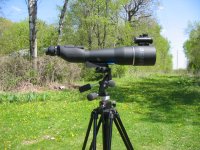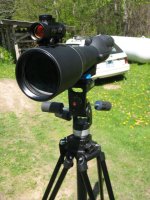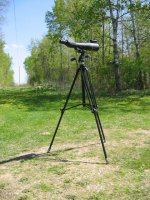The Pentax forum has been more or less moribund lately so I thought I
would throw this in just to give folks something to kvetch over.
First of all this is an evaluation of of the Pentax 100mm spotting
scope as a visual device and has nothing to do with digiscoping which
I'm not competent to comment on.
Both my wife and I are birders. Although we have been happy with the
Pentax 80mm often we have felt the need for more than one scope because
of our different birding interests. She tends to be chasing small
passerines relatively close and I tend to be looking for raptors,
waterfowl and shorebirds at a great distance. Also we often are going
out with separate birding parties- she to chase woodland warblers and I
down to the lowlands for shorebirds.
Because of this, I have felt the need for more power than the 80mm can
deliver as well as having my own scope. While the 80mm is a fine scope
it's really only practical out to 40x and a little beyond with just the
right ep.
Let me say up front that I have had access to most of the high-end
scopes such as Swaro, Leica, Zeiss and even a Televue 85 and have used
them in the field under real birding conditions. None of them really
cut it much above 50x except for the exception of the Televue.
While the Televue may be good beyond 60x it is not really a true field
scope in my opinion. Big, bulky, clumsy, heavy, fragile with no
weatherproofing . The Televue is affectionately referred to in my
birding group as the "stovepipe". It may look impressive sitting on
some affluent doctor's porch but it's a failure as a true all-weather
field scope.
This is where I take exception with the basic premise of the Better
View Desired review of the Televue 85-...
http://betterviewdesired.com/BVD701/tv85.html
Tele Vue 85: an unconventional scope
clearly a new optical reference standard...
In this review he states:
"Okay, so why would anyone even think of carrying such an elephant into
the field after birds? I mean, 12 pounds might as well be a ton by the
end of a two mile hike or three hours into a CBC. Simple answer: the
view!"
I think his logic, or lack of it, is very flawed. If pure raw optical
performance was the reason for selecting the Televue 85 as "a new
optical reference standard" for birding scopes in a review dedicated
to optics for birders why stop there? Why not the Televue 102mm or 127mm
or, for that matter, My Pentax 100mm? Without any reference to anything
other than optical performance it's easy to find a scope that will
optically outperform the standard spotters most birders use.
He calls the Televue 85 an "unconventional" scope. There is nothing
unconventional about this scope. It is an entirely conventional high
quality APO scope designed from the ground up for the affluent amateur
astronomer. The only thing unconventional is to imply that one can
compare apples and oranges. This scope is designed for astronomical
observation not terrestrial wildlife observation. While the requirements
of the astronomer and birder are not mutually exclusive, to a great
extent, in fact, they are.
Given this, his "optical reference standard" becomes meaningless to
birders. His selection of the Teleview 85 as a optical reference
standard is completely arbitrary. It could have been, perhaps, 50 other
high quality astro scopes as well. It's easy to find a scope that
outperforms, say, the Swarovski ST80 HD if your only consideration is
"the view".
Not that a review of the Televue 85 should not have been done on the BVD
site. I personally found it interesting. But to list it as a "Optical
Reference Standard" in his Reference Set along with conventional field
spotting scopes implies a comparision that just cannot be made and is
not helpful if not misleading for those looking for a spotting scope for
birding. The Televue and Swarovski are apples and oranges.
So to say that the Televue 85 is optically superior to the Zeiss 85 is a
no-brainer- we already know that. So are any number of other scopes as
well. Such a statement gives us very little in the way of useful
practical information about either scope. Of course a Formula One racer
is faster than a family sedan. So what?
As far as the standard spotters most of us use are concerned, they fail
at high power because of simple physics - Too little aperture burdened
by too much optics between the objective and the eye.
My conclusion was that the only practical path to greater power was by
brute force-more aperture. Thus the 100mm Pentax.
So I got one along with a Bogen-Manfrotto 3246 tripod and a 3047 3 way
pan head. This combination has worked well so far.
High Power Optical performance...
Eps used in this evaluation:
9mm Burgess/TMB Planetary (70x)
7.5mm *Takahashi LE (a loaner) (83x)
5.7mm Antares W70 (110x)
5mm Burgess/TMB Planetary (125x)
The long and the short of it-
9mm at 70x-excellent. About as bright at 70x as my 13mm Stratus is at
40x on the 80mm. Good contrast and excellent sharpness. Better
performance than I had hoped for.
7.5mm at 83x-excellent see above. No real difference from 9mm other
than being very slightly darker.
NOTE: It is my gut feeling that right around 7mm at 90x might be the
sweet spot for this scope. By "sweet spot" I mean where one is at
maximum power WITHOUT any substantial, observable loss in visual quality.
Beyond this and you begin to push the objective too hard and you start
to see an observable loss of acuity, contrast and vividness. By
comparison I have found the sweet spot on the 80mm to be a 13mm ep (40x).
5.7mm at 110x-decent. Surprised me with it's good contrast and adequate
brightness at this power. Was somewhat soft. This is a hard one to
compare because it's a 50 buck ep and not in the same class as the
others.
5mm at 125x-Useable on the bright overcast day I was using it. Contrast
was good with some fuzziness. At the practical limit of the 100mm.
Beyond this is empty magnification at least for daytime terrestrial
wildlife observation.
My overall impression is that the 100mm may be built to a slightly
higher standard than the 80mm. At similar low powers the 100mm still
gave slightly more vivid detailed images than the 80mm even though
brightness was similar in both scopes. It might be simply a variation in
quality control as well. I really don't know.
Cons:
The tripod mounting bracket is not well designed for a scope of this
size and weight. The bracket is a long L shaped affair coming off the
barrel collar and cantilevered forward about 5 inches. There are 3
mounting holes and all them make the scope front heavy. The best
position, as far as balance is concerned, is far forward but this
causes the cantilevered bracket to flex and gives the view jitters at
high power. In this position it is still too front heavy. It helped
some to put a wedge between the end of the bracket and the bottom of the
barrel thus relieving some of the stress on the bracket. See picture. I
put a comb where I think a wedge might be helpful.
The objective lens cover is not very secure and tends to fall off in
the field.
All in all the scope did what I had hoped-give me useful high power
performance beyond the 80mm in a field worthy package. This is, of
course, always qualified by assuming atmospheric conditions allow the
use of high power eps in the first place.
This is getting too long- I've got too much time on my hands and think
I'll get out and smell the spring flowers.
Good birding,
SF
would throw this in just to give folks something to kvetch over.
First of all this is an evaluation of of the Pentax 100mm spotting
scope as a visual device and has nothing to do with digiscoping which
I'm not competent to comment on.
Both my wife and I are birders. Although we have been happy with the
Pentax 80mm often we have felt the need for more than one scope because
of our different birding interests. She tends to be chasing small
passerines relatively close and I tend to be looking for raptors,
waterfowl and shorebirds at a great distance. Also we often are going
out with separate birding parties- she to chase woodland warblers and I
down to the lowlands for shorebirds.
Because of this, I have felt the need for more power than the 80mm can
deliver as well as having my own scope. While the 80mm is a fine scope
it's really only practical out to 40x and a little beyond with just the
right ep.
Let me say up front that I have had access to most of the high-end
scopes such as Swaro, Leica, Zeiss and even a Televue 85 and have used
them in the field under real birding conditions. None of them really
cut it much above 50x except for the exception of the Televue.
While the Televue may be good beyond 60x it is not really a true field
scope in my opinion. Big, bulky, clumsy, heavy, fragile with no
weatherproofing . The Televue is affectionately referred to in my
birding group as the "stovepipe". It may look impressive sitting on
some affluent doctor's porch but it's a failure as a true all-weather
field scope.
This is where I take exception with the basic premise of the Better
View Desired review of the Televue 85-...
http://betterviewdesired.com/BVD701/tv85.html
Tele Vue 85: an unconventional scope
clearly a new optical reference standard...
In this review he states:
"Okay, so why would anyone even think of carrying such an elephant into
the field after birds? I mean, 12 pounds might as well be a ton by the
end of a two mile hike or three hours into a CBC. Simple answer: the
view!"
I think his logic, or lack of it, is very flawed. If pure raw optical
performance was the reason for selecting the Televue 85 as "a new
optical reference standard" for birding scopes in a review dedicated
to optics for birders why stop there? Why not the Televue 102mm or 127mm
or, for that matter, My Pentax 100mm? Without any reference to anything
other than optical performance it's easy to find a scope that will
optically outperform the standard spotters most birders use.
He calls the Televue 85 an "unconventional" scope. There is nothing
unconventional about this scope. It is an entirely conventional high
quality APO scope designed from the ground up for the affluent amateur
astronomer. The only thing unconventional is to imply that one can
compare apples and oranges. This scope is designed for astronomical
observation not terrestrial wildlife observation. While the requirements
of the astronomer and birder are not mutually exclusive, to a great
extent, in fact, they are.
Given this, his "optical reference standard" becomes meaningless to
birders. His selection of the Teleview 85 as a optical reference
standard is completely arbitrary. It could have been, perhaps, 50 other
high quality astro scopes as well. It's easy to find a scope that
outperforms, say, the Swarovski ST80 HD if your only consideration is
"the view".
Not that a review of the Televue 85 should not have been done on the BVD
site. I personally found it interesting. But to list it as a "Optical
Reference Standard" in his Reference Set along with conventional field
spotting scopes implies a comparision that just cannot be made and is
not helpful if not misleading for those looking for a spotting scope for
birding. The Televue and Swarovski are apples and oranges.
So to say that the Televue 85 is optically superior to the Zeiss 85 is a
no-brainer- we already know that. So are any number of other scopes as
well. Such a statement gives us very little in the way of useful
practical information about either scope. Of course a Formula One racer
is faster than a family sedan. So what?
As far as the standard spotters most of us use are concerned, they fail
at high power because of simple physics - Too little aperture burdened
by too much optics between the objective and the eye.
My conclusion was that the only practical path to greater power was by
brute force-more aperture. Thus the 100mm Pentax.
So I got one along with a Bogen-Manfrotto 3246 tripod and a 3047 3 way
pan head. This combination has worked well so far.
High Power Optical performance...
Eps used in this evaluation:
9mm Burgess/TMB Planetary (70x)
7.5mm *Takahashi LE (a loaner) (83x)
5.7mm Antares W70 (110x)
5mm Burgess/TMB Planetary (125x)
The long and the short of it-
9mm at 70x-excellent. About as bright at 70x as my 13mm Stratus is at
40x on the 80mm. Good contrast and excellent sharpness. Better
performance than I had hoped for.
7.5mm at 83x-excellent see above. No real difference from 9mm other
than being very slightly darker.
NOTE: It is my gut feeling that right around 7mm at 90x might be the
sweet spot for this scope. By "sweet spot" I mean where one is at
maximum power WITHOUT any substantial, observable loss in visual quality.
Beyond this and you begin to push the objective too hard and you start
to see an observable loss of acuity, contrast and vividness. By
comparison I have found the sweet spot on the 80mm to be a 13mm ep (40x).
5.7mm at 110x-decent. Surprised me with it's good contrast and adequate
brightness at this power. Was somewhat soft. This is a hard one to
compare because it's a 50 buck ep and not in the same class as the
others.
5mm at 125x-Useable on the bright overcast day I was using it. Contrast
was good with some fuzziness. At the practical limit of the 100mm.
Beyond this is empty magnification at least for daytime terrestrial
wildlife observation.
My overall impression is that the 100mm may be built to a slightly
higher standard than the 80mm. At similar low powers the 100mm still
gave slightly more vivid detailed images than the 80mm even though
brightness was similar in both scopes. It might be simply a variation in
quality control as well. I really don't know.
Cons:
The tripod mounting bracket is not well designed for a scope of this
size and weight. The bracket is a long L shaped affair coming off the
barrel collar and cantilevered forward about 5 inches. There are 3
mounting holes and all them make the scope front heavy. The best
position, as far as balance is concerned, is far forward but this
causes the cantilevered bracket to flex and gives the view jitters at
high power. In this position it is still too front heavy. It helped
some to put a wedge between the end of the bracket and the bottom of the
barrel thus relieving some of the stress on the bracket. See picture. I
put a comb where I think a wedge might be helpful.
The objective lens cover is not very secure and tends to fall off in
the field.
All in all the scope did what I had hoped-give me useful high power
performance beyond the 80mm in a field worthy package. This is, of
course, always qualified by assuming atmospheric conditions allow the
use of high power eps in the first place.
This is getting too long- I've got too much time on my hands and think
I'll get out and smell the spring flowers.
Good birding,
SF







